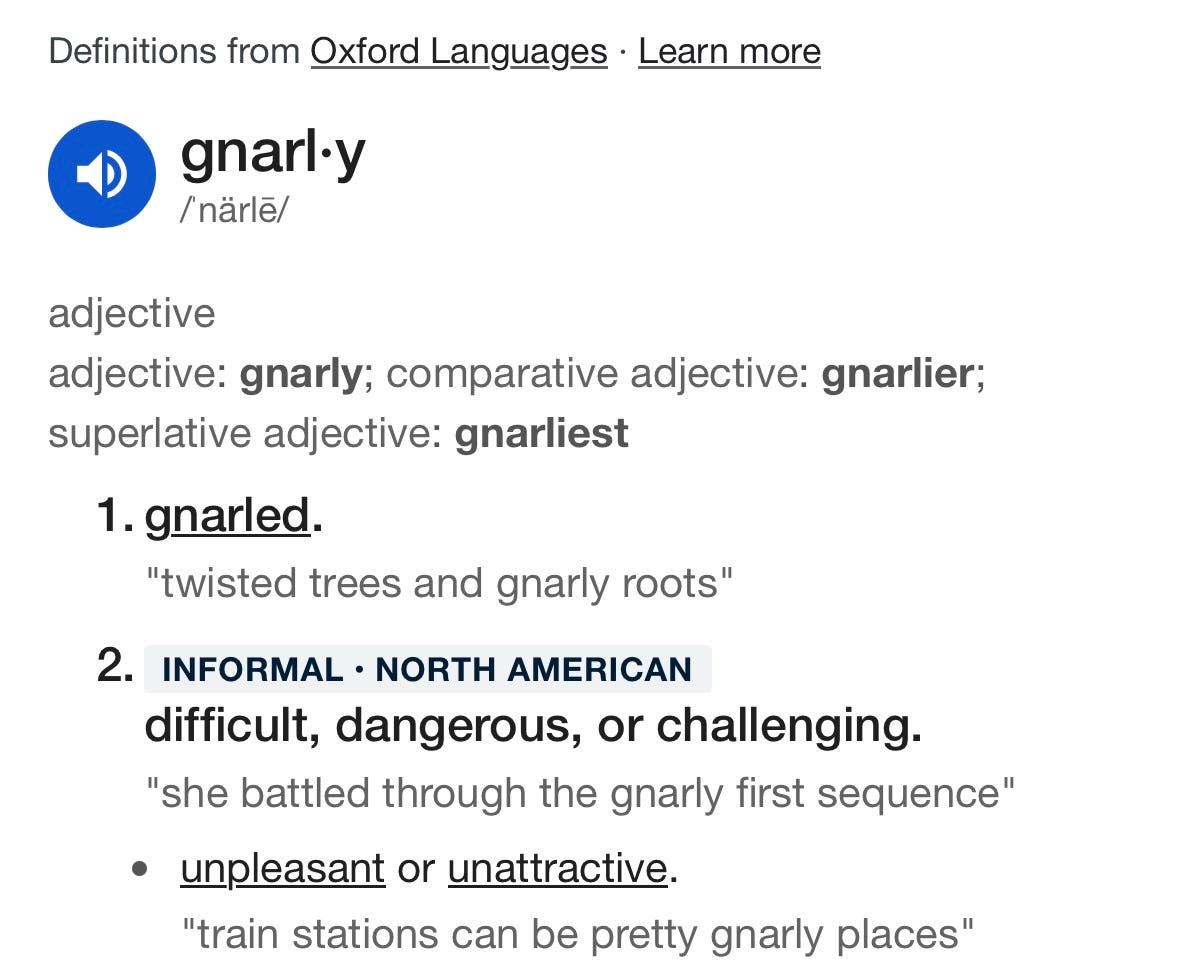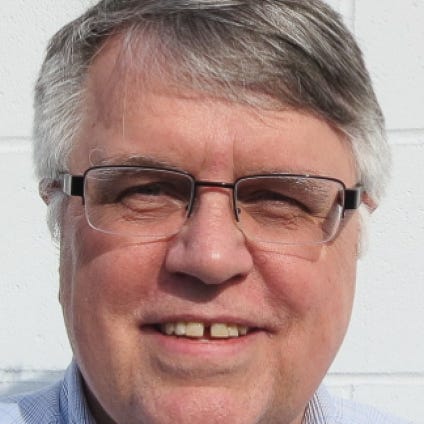A gnarly fork in the path to affordability
CC #162—a summer of reflection and gathering thoughts
These two magnificent, gnarly trees mark the fork in a path in Helliwell Park on Hornby Island—photo watercolour by Brian Palmquist
I have been lucky enough to spend a few weeks each summer with my family in a rented cabin on Hornby Island—our rental locations and time away have varied over the years but we’ve cherished it as a time to spend with family and friends and reflect on the year’s experiences and the road ahead.
My City Conversations have been silent this year during this time away. We had internet in this year’s cabin, so I have been monitoring events, mostly with dismay. I’ve also been pondering how best to have impact in the urban design and planning arenas where I have some experience and expertise.
Many aspects of urban design and planning are being well covered by the two dozen or so like minded folks who allowed me to add my name to their thoughtful letters to municipal, provincial and federal politicians about advancing housing affordability—I certainly agree with their recommendations, have been amazed at how these many folks have collectively and respectfully crafted and edited communications with our elected officials. It’s been a master class in the type of consultation and respect that should attend all public debate and decision, yet is sadly lacking in most communications between electors and the elected.
I feel we are reaching a fork in the path to a better Vancouver in a better British Columbia and Canada. But it’s a gnarly fork—difficult, dangerous and challenging at least, perhaps unpleasant as well if we don’t get it right—a textbook example of the above definition of gnarly.
One path, currently in application, continues recent autocratic tendencies of government at all levels—the top down approach that favours a few at the expense of all that has historically made our communities livable, even enjoyable. That path sacrifices the future of not just communities of people, but the web of amenities that allow every citizen to participate and benefit: at the emotional/spritual/climate level, community centres, parks, open spaces and schools come to mind; and at the infrastructure level, prosaic but essential elements such as water supply, sewers, power and transportation. At the moment, most of these amenities are being ignored or downloaded at municipal and provincial levels at least. As examples: recently completed residential developments1 are unable to open due to the absence of sufficient infrastructure; and none of the newly-approved Official Development Plans2 makes meaningful provisions for sufficient community facilities, parks or schools.
The other path from this fork starts by recognizing the need to accommodate more citizens and better care for them as well as those citizens we already have. It embraces true community consultation as the precursor, not the sham that has captured our bureaucracies3 and the politicians they more than ever seem to control4. It allows government to take action quickly but only after that meaningful public consultation has occurred, including making the hard decisions that arise when there is not enough to go around. As an example of how that can work, the False Creek North Official Development Plan (ODP) was approved in just 18 months after its planning work started, largely because of its developers agreeing to include new parks, waterfront walkways, schools and a community centre, respecting existing view cones and hosting dozens of meaningful5 community meetings—as a result the ODP came to Council with strong public support.6
Either of these paths will be gnarly. The current path will continue to disaffect most citizens as it attempts to impose massive density on unsuspecting7 existing communities and neighbourhoods with no forethought about the impacts of helter skelter development and little thought for those who will be evicted from affordable homes, nor for those who will remain with inadequate schools, parks and community centres.
The second path, which I clearly favour despite its challenges, will require current residents and government of almost every communtiy in the province to do the hard work of coming together to identify where and how much new development can be accommodated, and over what time frames. Preconceptions must be left at the door. Compromises, including some painful ones, will need to be understood and agreed to by the governments and the governed.
I am committed to the second path, so invite readers to communicate with me around their proposals for how to forge our way ahead on the path together.
This post is just over 700 words, a bit more than the 3-5 minutes citizens are allowed when they speak to the current City Council, in their efforts to suppress democracy. If you appreciated it, share to your social media—Facebook seems to be blocking me— and consider becoming a free subscriber to City Conversations at
Brian Palmquist writes on the traditional, ancestral and unceded lands of the Musqueam people. He is a Vancouver-based architect, building envelope and building code consultant and LEED Accredited Professional (the first green building system). He is semi-retired, still teaching, writing and consulting a bit, but not beholden to any client or city hall. City Conversations mix real discussion with research and observations based on a 50-year career including the planning, design and construction of almost every type and scale of project. He is the author of the Amazon best seller and AIBC Construction Administration course text, “An Architect’s Guide to Construction.” A glutton for punishment, he recently started writing a book about how we can Embrace, Enhance and Evolve the places where we love to live. Some of its content may appear above.
Specifically we are aware of a multifamily development along the Arbutus corridor that lacks sufficient sewer capacity to occupy. I am sure there are others.
Here I include the Broadway Plan (which includes a paltry financial allowance but no land for facilities), Jericho (where amenities only arise with the final phases of development), Oakridge and Senakw’. I am sure there are others.
In an unguarded moment, a young Vancouver planner admitted they had received no instruction either at university or on the job about how to consult with the public at, for example, the public meeting where I asked the question.
Here I generalize, noting that recently the Mayors of Pitt Meadows, Burnaby and Port Coquitlam as well as others I have missed have objected to the first path.
I use the term “meaningful” because at each of these meetings senior members of the planning and design teams were present, taking notes of conversations with the public, caucusing afterwards to amend plans arising from public input.
I had the privilege of serving as Managing Architect for the False Creek North ODP so have first hand knowledge of the processes and timelines.
I say “unsuspecting” because despite all of the media and public coverage, most proposals are met by the communities they affect with surprise.





I am not a professional and I offer my independent thoughts.
I think we have crossed the "Rubicon" with the housing issue and the government, hell bent on a yet made public (as of now) secret politcal agenda, refuses to deal with the realities of the housing issue.
The utter and complete failure of the government to address the issue in any meaningful way the government and bureacrats instead uses "word salads" of cliched 10 second sound bytes for the evening news to promote the current secret agenda.
What needs to be done is not done and instead government keeps doing the same thing over and over again ever hoping for different results. Both the Government and the Bureaucracy cannot or will not think "out of the box" and they have collectively boxed themselves in a "no-win" situation.
Currently there is now close to 3,000 unsold condominiums on the the market, but in the real sense they are not livable, especially if one has children. Expensive warehousing, is what is being created, not communities, not livable accommodations, but dog kennel living.
Instead of government policies to encourage business to locate outside of the lower mainland or investments in rail communication within the province to promote this, the government (the NDP has doubled down on this) compels densification as it has become the great philosopher's stone to cure homelessness.
It isn't and it won't. Towers, towers, towers is the clarion call of government, but with towers, towers, towers will come social decay, massive congestion (subways do not reduce congestion I am afraid) and the spread of homelessness, and tent cities.
The governments false god of density is slowly destroying Vancouver, as well like a cancer, spreading to the lower mainland. For metro Vancouver both provincial and civic politcans have paved over paradise and turned it into a parking lot.